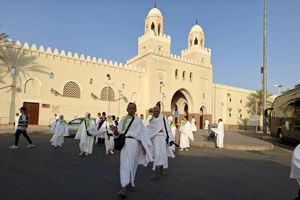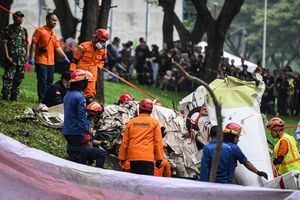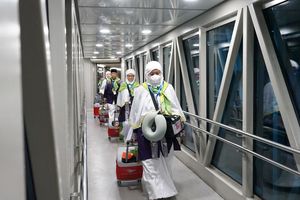Indonesia Volcano Burns Whole Villages; 122 Dead
Soldiers pulled at least 78 bodies from homes and streets blanketed by ash up to a foot (30 centimeters) deep Friday, raising the overall toll to 122, according to the National Disaster Management Agency.
With bodies found in front of houses and in streets, it appeared that many of the villagers died from the blistering gas while trying to escape, said Col. Tjiptono, a deputy police chief.
“The heat surrounded us and there was white smoke everywhere,” said Niti Raharjo, 47, who was thrown from his motorbike along with his 19-year-old son while trying to flee.
“There was an explosion ... and it got worse, the ash and debris raining down,” he said from a hospital.
The living — with clothes, blankets and even mattresses fused to their skin by the 1,400-degree Fahrenheit (750-degree Celsius) heat — were carried away on stretchers following the first big explosion just before midnight.
More than 150 injured people — with burns, respiratory problems, broken bones and cuts — waited to be treated at the tiny Sardjito hospital, where the bodies piled up in its morgue, and two other hospitals.
Despite being at the foot of Indonesia’s deadliest volcano, Yogyakarta has only one burn unit — at Sardjito. The facility is limited to 10 beds, though, and so turns away any patient without facial burns or whose body is burned less than 40 percent, according to Sigit Priohutomo, a senior official at Sardjito. “We’re totally overwhelmed here!” hospital spokesman Heru Nogroho said. More than 100,000 people living on the mountain have been evacuated to crowded emergency shelters, many by force, in the last week.
Some return to their villages during lulls in activity, however, to tend to their livestock. They were told to stay away Friday.
The government also announced an $11 million program to buy the cows on the mountain to keep farmers off its slopes, and to provide compensation for animals lost in the eruptions.
Indonesia, a vast archipelago of 235 million people, is prone to earthquakes and volcanoes because it sits along the Pacific “Ring of Fire,” a horseshoe-shaped string of faults that lines the Pacific Ocean.
While Friday’s explosion was the largest in volume in a century, an eruption at Merapi in 1930 killed many more — 1,300. Even that toll pales in comparison to other volcanoes in the region: Indonesia’s Krakatoa killed at least 36,000 people in 1883, in an eruption that could be heard 2,000 miles (3,200 kilometers) away and blackened skies region-wide for months.
When the Philippines’ Mount Pinatubo exploded in 1991 after a 500-year slumber, about 800 people died as the billions of tons of volcanic debris poured from the cone, erasing entire farm communities and altering the world’s climate. The May 1980 eruption of Mount St. Helens caused the volcano’s north flank to collapse, triggering the largest landslide ever recorded.
The blast killed 57 people, flattened 230 square miles (596 square kilometers) of forests and blew 1,300 feet (400 meters) off the peak.
Simak breaking news dan berita pilihan kami langsung di ponselmu. Pilih saluran andalanmu akses berita Kompas.com WhatsApp Channel : https://www.whatsapp.com/channel/0029VaFPbedBPzjZrk13HO3D. Pastikan kamu sudah install aplikasi WhatsApp ya.





















